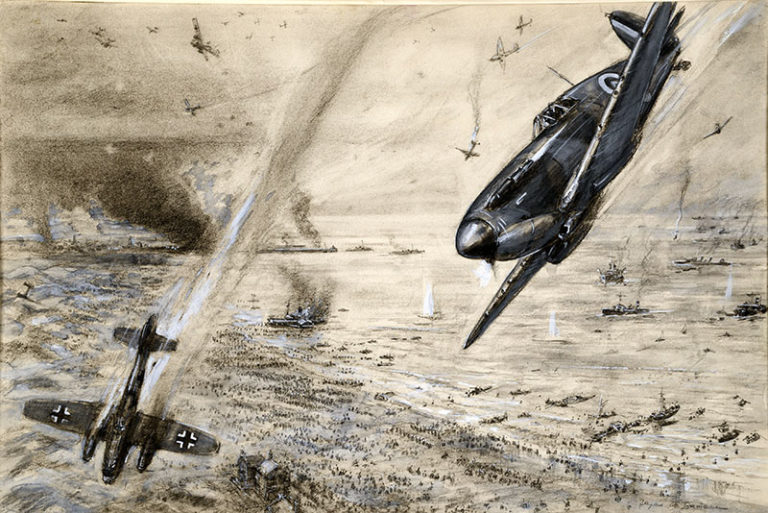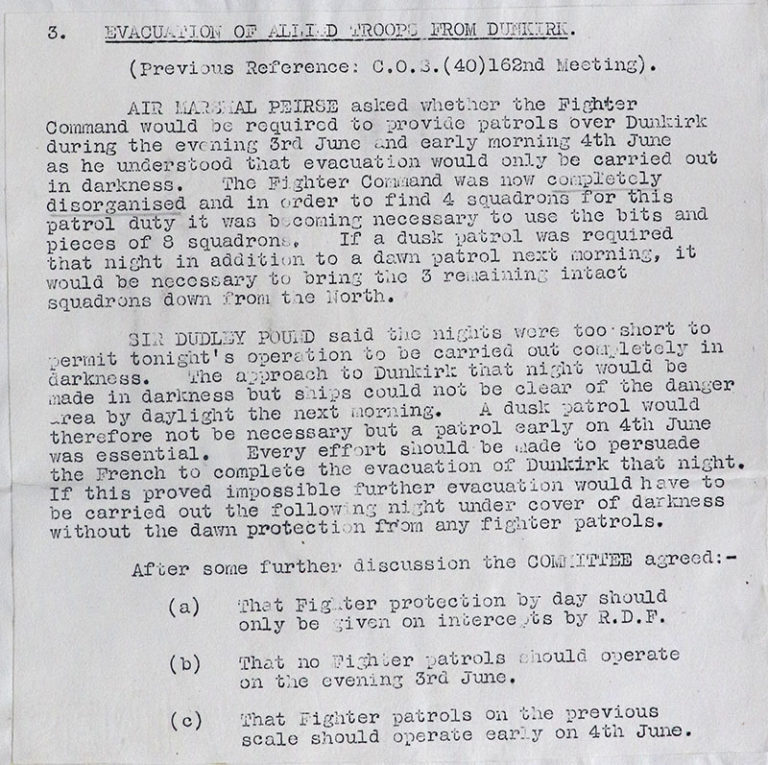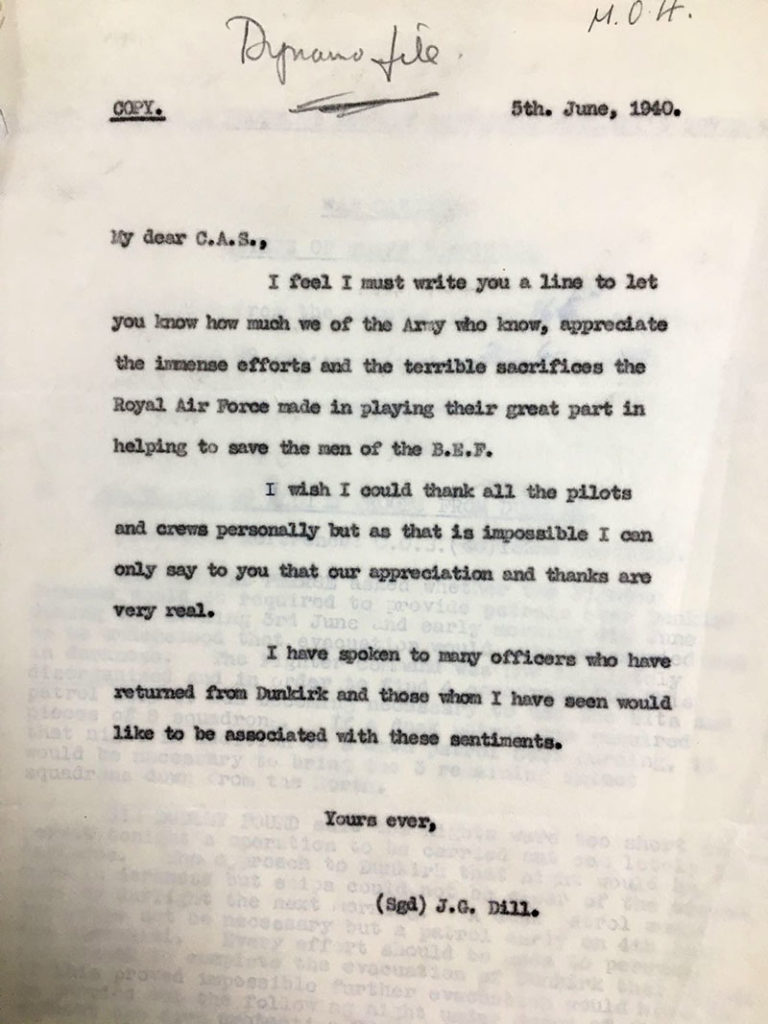
On 10 May 1940, Hitler’s forces suddenly opened their offensive in Western Europe. Attacking through neutral Belgium and Luxembourg, they soon shattered the Allied defences and threw the British and French armies into disarray. Within 10 days, the Luftwaffe ground down RAF fighter squadrons operating as part of the ‘Advanced Air Striking Force’, sent in support of the British Expeditionary Force (BEF) in France. Hurricane fighter pilots, though they had fought heroically, were vastly outnumbered and forced to retreat with the remnants of their squadrons among the retreating armies and fleeing civilians[ref]Norman Franks, Air Battle for Dunkirk: 26 May – 3 June 1940 (London: Grub Street, 2000), p 11.[/ref].
The survivors of these squadrons would very soon be withdrawn, and fighter squadrons operating from Britain would be tasked with providing air cover for the BEF as they fell back to the northern French coast. However, Wehrmacht Panzer divisions had punched through the Allied lines and drove for the main British embarkation and supply ports in France. By 26 May, both Calais and Boulogne had fallen to the Germans, leaving the small port and seaside resort town of Dunkirk as the only location from which to evacuate the BEF.
One of the greatest myths of the Second World War was that the RAF did not do enough to protect British soldiers trapped in the Dunkirk salient or to support the Royal Navy warships which were sent to evacuate them. From the 27 May, the second day of ‘Operation Dynamo’, the operation to rescue the BEF from the beaches of Dunkirk, the RAF began a supreme effort to beat off Luftwaffe air attacks on British vessels crossing the English Channel, lifting troops from the beaches or loading them aboard at the Mole. Fighter Command would commit 16 front line fighter squadrons to the fray in order to provide continuous air cover throughout the evacuation. On that first day alone, 287 fighter sorties were flown over the approaches to the port[ref]Julian Thompson, Dunkirk: Retreat to Victory (London: Pan Macmillan, 2009), p 227.[/ref].
Over the nine days of operations, the RAF carried out 171 reconnaissance, 651 bombing and 2,739 fighter sorties, losing 177 aircraft, including 106 fighters, bringing the total number of fighters lost in the whole Battle of France campaign to 250. The losses over Dunkirk reduced the strength of Fighter Command to 570 operation fighters; 280 Spitfires and 290 Hurricanes, the latter of which included three squadrons in France.
With these numbers, Air Chief Marshall Sir Hugh Dowding of Fighter Command, in his 3 June air assessment to the War Cabinet, had gloomily predicted that his squadrons could not guarantee anything more than 48 hours of air superiority against a concerted Luftwaffe attack[ref]Hugh Sebag-Montefiore, Dunkirk: Fight to the Last Man (Cambridge MA: Harvard University Press, 2006), p 440.[/ref].
It is, therefore, clear that the RAF made a tremendous effort and endured much sacrifice to provide air cover for the evacuation of the BEF throughout Operation Dynamo, almost to a point of imperiling the air defences of Britain itself.
However, in spite of their overwhelming effort, the slur against the RAF began as soon as the evacuation ended. A familiar series of remarks from the mouths of many evacuated British soldiers during and after the ordeal included ‘Where is the RAF?’ and ‘We never saw a fighter!’[ref]Thompson, Dunkirk, p 227.[/ref].
Despite the complaints of their comrades in arms in the years and decades that followed, evidence of the RAF’s role in the evacuation is ubiquitous, especially within the records of the War Office and Admiralty pertaining to Operation Dynamo. Within ADM 199/786, especially, there are some striking accounts which bear testament to the consistent role of the RAF in the events at Dunkirk, while WO 106/1613 contains official evidence of the herculean efforts made by Fighter Command squadrons, already decimated and disorganised after the Battle of France, against overwhelming odds and under the most strained circumstances.
A number of reports from Royal Navy destroyers described the presence of the RAF in the skies above Dunkirk. One report from the commander of HMS Montrose, dated 2 June, described the crossing over the Northern Channel to Dunkirk on 27 May:
‘The weather was calm and fine on the way across, with fairly high clouds. At one period a tremendous air battle was heard going on above the clouds but none of the actual fighting was seen’ (ADM 199/786)[ref]ADM 199/786, Report from Commanding Officer of HMS Montrose: proceedings for the period 27 May to 1 June, 2 June 1940.[/ref].
In his report of 19 June, the commander of HMS Wivern recorded the following for Friday 31 May:
‘No interference from enemy action was experienced on passage, though between F.G. Buoy and W. Buoys some bombing was observed about a mile ahead, apparently ineffective. RAF fighters soon appeared and no further enemy air action was observed’ (ADM 199/786)[ref]ADM 199/786, Report from Commanding Officer of HMS Wivern: Evacuation of French and British troops from Dunkirk (31 May to 3 June), 19 June 1940, p 1.[/ref].
Wivern made the passage, embarked a contingent of troops at Dunkirk, and returned to Dover without incident that day. However, during the early hours of the following morning, Saturday 1 June, as Wivern crossed the Channel on another run to Dunkirk, they observed another ship coming under attack from German fighters. Wivern’s anti-aircraft crews immediately engaged the fighters, but the ship’s captain also noted the fast response of the RAF to the enemy attack:
‘After passing F.G. Buoy, 9 fighters were observed and at first thought to be friendly. They were later seen to be Messerschmitts and soon after this was established they attacked a ship about 3 cables on the port quarter with tracer ammunition. Fire was opened and was effective in preventing further attacks. Other fighters approached later and were identified as Spitfires’ (ADM 199/786)[ref]Ibid, p 2.[/ref].
HMS Sabre had the most active involvement in the evacuation of all Royal Navy ships which took part in Dynamo, and made more round trips than most. Sabre’s commanding officer, Lieutenant-Commander Dean, who would be awarded the Distinguished Service Order for the conduct of his ship throughout Dynamo[ref]Walter Lord, The Miracle of Dunkirk (London: Wordsworth Military Library, 1998), p 116.[/ref], recorded persistent air attacks during the evacuation, but also the active presence of the RAF.
On the morning of 28 May, for instance, while Sabre stood off the entrance of Dunkirk harbour alongside Montrose, waiting to embark troops from the Mole, they observed “a forced-landed” Hurricane aircraft on the beach west of Dunkirk’. A motor boat was launched to recover the pilot, but the effort failed when they ran aground in a ‘falling tide’ (ADM 199/786)[ref]ADM 199/786, Report from Commanding Officer of HMS Sabre: Proceedings by HMS Sabre for the period 27 May to 5 June, 8 June 1940, p 1.[/ref].
On 1 June, as Dynamo was reaching its climax, Sabre stood off Bray Dunes, east of Dunkirk, and sent boats in to take troops off the beach. While the ship was taking troops from a tug on orders from ‘Vice-Admiral Dover’, they came under air attack. Sabre’s account of the incident bears out that RAF intervention had a mitigating impact:
‘During this time a single aircraft (apparently a Messerschmitt 109) approached and made some rather half-hearted machine gun attacks. Intense A.A. fire prevented these from being pressed home. There was also an unsuccessful dive bombing attack by a Junkers 87. Numerous British fighters were seen, and our freedom from serious interference was presumably due to them’ (ADM 199/786)[ref]Ibid, p 5.[/ref].
Even within the War Office records documenting the course of the evacuation, one can find testaments from the Army to the immense undertakings of the RAF to ensure that the BEF returned home safely.
Such praise was not understated. According to the minutes of the Chiefs of Staff meeting of 3 June, Air Marshal Peirse outlined the desperate state of Fighter Command to the heads of the other services, describing the command as ‘completely disorganised’. It was clear that the strain upon the front line fighter squadrons was becoming intolerable, with four squadrons being cobbled together from the remnants of eight in order to sustain patrol duty.
Peirse plainly told his Army and Navy counterparts that if fighter patrols were required over Dunkirk at dusk that day, as well as a dawn patrol on the morning of 4 June, Fighter Command would need to summon its three intact squadrons in the north. Mercifully, the First Sea Lord, Admiral of the Fleet, Sir Dudley Pound, informed Peirse that the final round trip by Royal Navy vessels would be made under the cover of darkness, meaning a dusk patrol would not be necessary and that only a dawn patrol would be required (WO 106/1613).

In the opinion of retired Royal Marine officer and military historian, Major General Julian Thompson, the claims of returning British soldiers who complained that they never saw the RAF in the skies over Dunkirk belies the reality of what their Air Force colleagues actually accomplished for their sake. ‘Although aircraft might not have been visible overhead for most of the time’, in Thompson’s view ‘the RAF’s superb performance was critical in keeping the Luftwaffe from having a free run over the bridgehead, and without it only a fraction of the BEF would have been evacuated’[ref]Thompson, Dunkirk, p 227.[/ref].
On 4 June, the need for RAF air cover for Operation Dynamo came to an end when the evacuation was formally terminated. On the following day, 5 June, the recently-appointed Chief of the Imperial General Staff, Field Marshal Sir John Dill, wrote a moving letter to the Chief of the Air Staff, Sir Cyril Newall, in which he paid a shining tribute to the RAF (WO 106/1613):

Hitler’s forces also attacked The Netherlands, who were also neutral, to put pressure on Belgium, particularly on the port of Antwerp.
Another comprehensive post on a subject that bobs to the.surface from time to time and a good companion to the (British Channel 4) tv documentary ‘Dunkirk – the new evidence’ that is shown on occassions on terrestrial television and is probably available through that company’s on-demand service in the UK.
Anyone who doubts the courage and commitment of the RAF during the Dunkirk evacuation need only to read the story of Henry Peter Dixon detailed in Air 81/258, when he was posted missing after having run out of fuel while chasing a German fighter and hhaving landed at an abandoned Belgian airfield on 11 May 1940, was then almost shot as a spy by Belgian troops – his French was was judged too perfect for an Englishman – before returning to his unit.
Sadly as a subsequent file (Air 81/727) he was shot down on 1 June 1940 over Dunkirk. Badly burned, he died at a casualty station there.
Reading both files shows the emotional toll on his family as first he is reported missing, then safe and less than a month later he is reported missing again.
The letters from his father (if I recall correctly) illustrate how desperate they were for definite news in an age before almost-instant access to 24 news, emails and mobile ‘phones as well as the efforts by the Casualty Branch to give them valid information.
Unfortunately because of local circumstances it would be many months before his fate was known with certainty – see Air2/6330 enclosure 10d.
Did they record the names of the troops coming back from Dunkirk.
My uncle told me of his experiences being over there, having to walk to Dunkirk before being taken back yo England.
His name was Charles Morehouse, a Canadian in the RAF. He was a rigger for the spitfires and the hawker hurricanes until the end of the war. At the end of the war, he was transferred into the RCAF to get home to Canada.
If you get direct me to that information I would greatly appreciate it.
My dad was a Lieutenant in the Polish forces who fought in the September 1939 campaign. He managed to make his way to Paris from Romania arriving there around the 8th January 1940 before ending up at La Rochelle on 19th June 1940 – and then across to Plymouth on the SS Alderpool, with several thousand other Polish troops arriving in Britain on 22nd June 1940. Often ignored by the media – the fact that many thousands did not manage to get across at Dunkirk.
Yes the role of the RAF at this point is often misunderstood. I am just completing a book on a pilot who served with 73 Squadron RAF, who along with 1 Squadron were part of the AASF during the Battle of France. Although he was killed during the Battle of Britain, he left behind a diary of his time in France and it is extraordinarily moving. This was perhaps the first diary of its type (permitted) to be put into print in 1940, and not been seen since then. The Air Ministry files from P4 Casualties at The National Archives have helped to open up the story of the tremendous anxieties he and his family experienced. His closest friend in the RAF was killed in combat in France on the 3rd June 1940, and his body lay undiscovered for 6 years, the family told initially in 1940 he was a POW. Tremendous sacrifices were made by so many, and should not be forgotten.
My father, who was a dispatch rider to the 2nd Light Anti-aircraft Battery, was sent off to Brussels,. early on the morning of the 10th May 1940, to pick up a senior officer at St Margaret’s hospital. The officer never turned up and at 15.00 hrs the battery’s other dispatch rider, Frederick Compton, arrived to tell him to return. Compton went missing about two weeks later and was presumed to have been killed.
There is no doubt that the Royal Air Force saved the BEF from a total tragedy. People expect much more than the real potential and men power of every military unit. The high rate of losses of the RAF is the best evidence that it did its best to protect the poor surrendering soldiers. That does not mean that the British pilots were inferior to the Germans, but one should take into consideration the fact that they were in a most difficult task – inferior in numbers. Being in some similar situation I can confess that you always wait for miracles coming from the skies… but it isn’t as simple as the infantry think it is.
Dr. Yaacov Nir, Israel
PS -Excuse me if my language isn’t Oxfordian enough. 2. There are no perfect wars.
Flagging up that today is the 80th anniversary of the bombing of SS Clan MacAlister, requisitioned to take the landing craft coming off the production lines of Hampshire to the beaches of Dunkerque.
This cargo ship was over 6,000 tons and hence was an obvious target for German bombers. She was hit whilst off the beach offloading her cargo at around 15.30 and embarking troops and nurses. Her remaining crew and officers and embarked troops were taken off by HMS Pangbourne and HMS Malcolm.
Of a crew complement of fifty-five men, forty-three from the Indian Merchant Navy, twenty were killed. Their names can be found on the CWGC site here*
INM pay was still at 50% of white crew rates despite reassurances given to IMN crews taking action in 1939 for better conditions that pay rates would change. These men are not commemorated at Tower Hill but in the Memorial Roll of Honour held in Bombay and Chittagong commemorating over 400 sailors of the former Indian Navy and over 6,000 sailors of the former Indian Merchant Navy who were lost at sea during the war years. They died whilst citizens of the united India but by the time of the memorial their country had become two, it has now become three and there is no memorial held in what is now Pakistan. (In the 1950s copies of this roll were placed in Westminster Abbey and St Paul’s Cathedral.)
The SS Clan MacAlister settled on the bottom with her upper structure still visible (and burning) and hence continued to be a diversionary bombing target saving other shipping. Her name crops up consequently in a number of logs and accounts, as a “navigational aid” but also as a refuge for men who swam and clung to the structure when ships they had been picked up by or commanded were in turn sunk (officers of HMS Keith?). She was finally sunk by the RN, possibly because smaller ships were still attempting to offload troops ono her or because she was blocking the channel.
Here is one of the few photographs I have been able to find of LC at Dunkerque, includes a photograph of the ship. http://www.bandcstaffregister.com/page4407.html
*https://www.cwgc.org/find/find-war-dead/results?servedWith=Indian&servedIn=Merchant%2Bnavy&exactDate=29-05-1940
I have nothing but admiration for all those taking part in this operation. Proud to be British!
My grandfather Sapper Martin Walsh. a Royal Engineer with 108 Field Park Corps, having joined the Army from his native Wigan, Lancs in 1930 was a member of the BEF. He was a lucky one who returned from Dunkirk after going missing for 3 days. For 21 years he ws a fabulous grandfather to me and my 2 brothers and 1 sister. He died in 1982 and I truly wish that I had asked more about his war service. His Army records say nothing about what he did in the BEF/ at Dunkirk nor how he got home
Bravery has no limits when the cause is just.